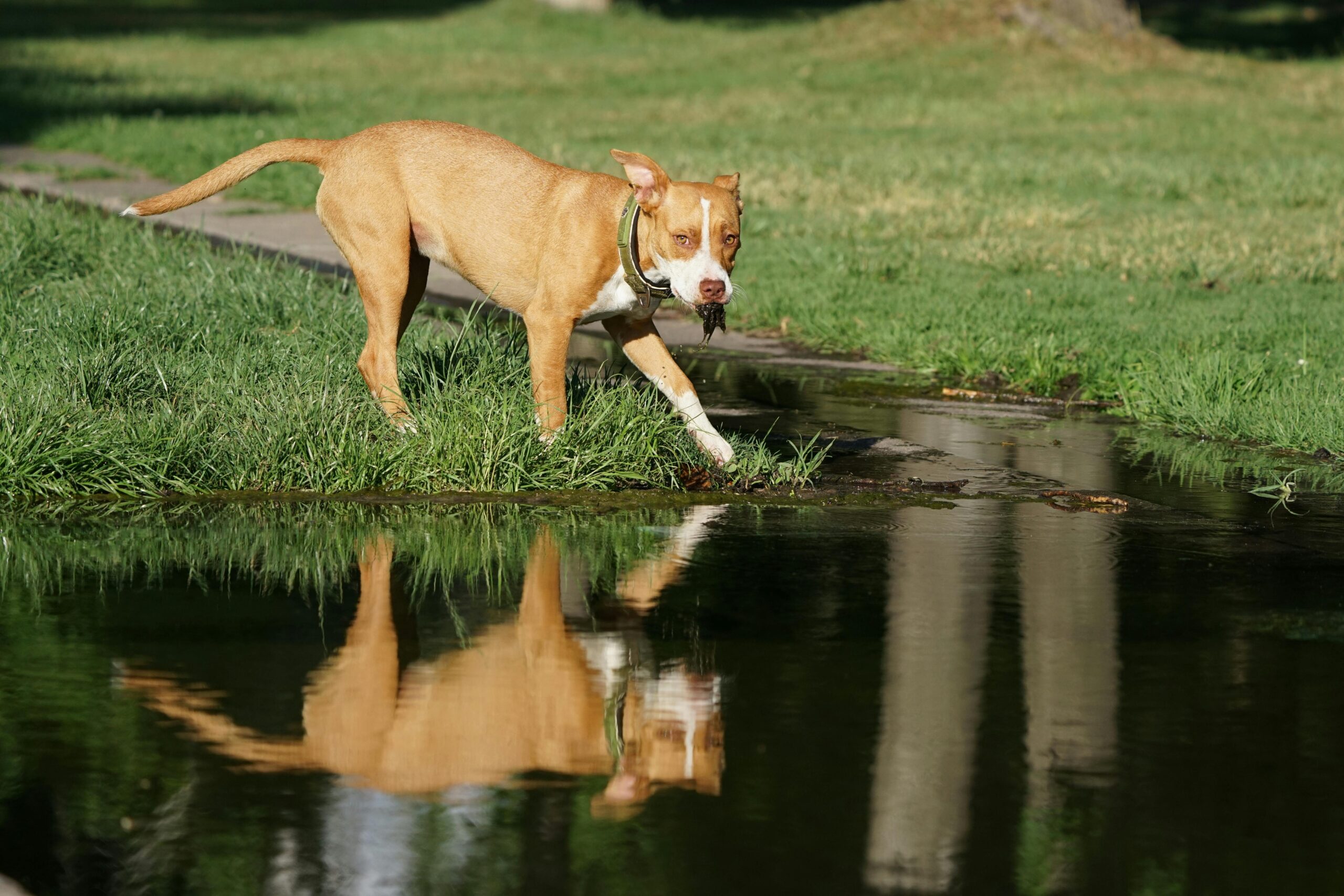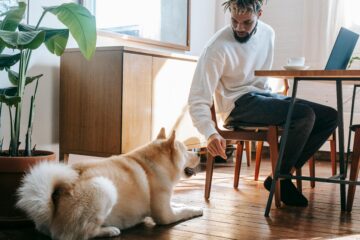Ever come home to a mess and wondered, Why Does My Dog Destroy My House?” Well, Living with a furry friend is amazing, but sometimes they can leave a bit of chaos in their wake.
In this guide, we’ll dig into the reasons behind your dog’s destructive habits and share 14 super practical tips to help you both coexist happily.
From chewed shoes to torn pillows, we’ve got you covered with insights and simple solutions that will make your home a more paw-friendly place.
So, let’s dive into the world of dog behavior and discover why your pup might be on a little home re-decorating spree!
Table of Contents
Decoding Canine Chaos: Tips on Why Does My Dog Destroy My House?

1] Boredom Busters
Dogs are intelligent beings that thrive on mental stimulation.
Combat potential boredom-related destructive behavior by incorporating enrichment activities into their daily routine.
Puzzle toys, treat dispensers, and interactive games engage your dog’s cognitive abilities, providing a healthy outlet for their mental energy.
Regularly rotating these activities keeps things exciting and prevents boredom, reducing the likelihood of your dog resorting to destructive habits when left alone.
2] Regular Exercise
A tired dog is a happy dog, and regular exercise is key to achieving this balance.
Plan daily walks, engaging play sessions, and interactive activities that match your dog’s energy level and breed characteristics.
Channeling their excess energy positively not only contributes to physical well-being but also significantly reduces the likelihood of restless dogs turning to destructive tendencies for stimulation.
Tip: “A tired dog is a content dog; ensure sufficient physical exercise to maintain a happy and well-behaved pet.”
3] Safe Spaces
Every dog needs a haven within your home.
Establish designated safe spaces equipped with comfortable beds and familiar items that carry your scent.
These cozy corners provide a retreat where your dog feels secure and at ease.
Having access to such havens reduces stress and the inclination towards destructive behavior, as your dog seeks refuge in their personalized sanctuary.
4] Crate Training
Consider crate training as a positive and secure retreat for your dog, especially when you’re away.
The crate serves as a den-like space where your dog can feel protected.
Ensure the crate is associated with positive experiences by gradually introducing it, placing treats or toys inside, and avoiding its use as a form of punishment.
A well-trained and comfortable crate becomes a sanctuary rather than a source of anxiety.
• Crate training offers a positive and secure retreat for your dog • The crate serves as a den-like space for protection • Associate the crate with positive experiences, using treats and toys • Avoid using the crate as a form of punishment to create a comfortable sanctuary
5] Separation Anxiety Solutions
Destructive behavior, often linked to separation anxiety, requires a gradual acclimation to alone time.
Ease your dog’s distress by leaving comforting items with your scent, playing soothing music, or incorporating pheromone diffusers.
Gradually increase the duration of separation, reinforcing positive experiences and minimizing anxiety triggers, ultimately reducing the likelihood of destructive behavior.
6] Interactive Toys
Interactive toys are excellent tools for distraction and mental engagement.
Toys that dispense treats, challenge problem-solving skills, or offer varied textures keep your dog occupied and mentally stimulated.
By redirecting their attention to these toys, you provide a healthy outlet for their chewing instincts, sparing your household items from potential destruction.
Offer a variety of interactive toys for mental stimulation and a healthy outlet for chewing instincts
7] Training Games
Stimulate your dog’s intellect through training games.
Teaching new tricks, reinforcing obedience commands, or introducing fun agility exercises not only provides mental challenges but also strengthens the bond between you and your furry companion.
Engaging your dog’s brain in positive and constructive ways contributes to a well-rounded and fulfilled canine.
8] Positive Reinforcement
Positive reinforcement is a powerful tool in shaping your dog’s behavior.
Acknowledge and reward good behavior with praise, treats, or affection.
Consistent positive reinforcement creates a positive association with desired actions, encouraging your dog to exhibit behaviors that lead to positive outcomes.
In the symphony of reinforcement, destructive notes fade, and harmonious behavior prevails.
9] Doggy Daycare
Enroll your dog in a reputable doggy daycare program to address both physical and social needs.
Regular interaction with other dogs, along with attentive supervision, prevents loneliness and boredom.
A well-structured daycare environment offers diverse activities, reducing the chances of your dog engaging in destructive tendencies associated with isolation.
10] Calming Aids
Explore natural calming aids to alleviate stress and anxiety.
Pheromone diffusers, calming sprays, and herbal supplements can provide a soothing effect.
Incorporating these aids, especially during potentially stressful situations, helps create a calming environment, reducing the triggers for destructive behavior.
Tip: “Calm your dog’s mind to minimize destructive behaviors associated with anxiety.”
11] Secure Chew Toys
Chewing is a natural instinct for dogs, and providing a variety of safe and durable chew toys is essential.
These toys satisfy your dog’s innate need to chew, redirecting their attention away from destructive habits.
Regularly inspect and rotate chew toys to keep them interesting and appealing to your dog.
12] Routine and Predictability
Dogs thrive on routine and predictability.
Establishing a consistent daily schedule for feeding, walks, and playtime creates a sense of security.
Knowing what to expect helps minimize stress-induced destructive behaviors, as your dog feels reassured and confident in the stability of their environment.
• Dogs thrive on routine and predictability • Establish a consistent daily schedule for feeding, walks, and playtime • Creates a sense of security and minimizes stress-induced behaviors • Your dog feels reassured and confident in the stability of their environment
13] Professional Advice
Persistent destructive behavior may require the expertise of a canine behavior specialist.
These professionals can assess the underlying causes, tailor strategies to your dog’s specific challenges, and provide guidance for promoting a harmonious home environment.
Seeking professional advice ensures a comprehensive approach to understanding and addressing your dog’s behavioral issues.
14] Vet Check
Before solely attributing destructive behavior to behavioral concerns, consult your veterinarian to rule out any underlying medical issues.
Pain, discomfort, or health problems can manifest in unusual behavior.
Addressing these concerns not only ensures your dog’s well-being but also eliminates potential physical discomfort as a factor contributing to destructive habits.
Tip: “Addressing health concerns is crucial for your dog’s well-being and can prevent destructive habits.”
Why Does My Dog Destroy My House? – FAQs
Can destructive behavior be a sign of a health problem?
Yes, it’s essential to rule out any medical issues causing discomfort or pain. Consult with your veterinarian to ensure your dog’s destructive behavior is not linked to an underlying health problem.
How can I tell if my dog has separation anxiety?
Signs of separation anxiety include destructive behavior when alone, excessive barking, pacing, and house soiling. Gradual desensitization to alone time and positive reinforcement can help ease separation anxiety.
Is crate training suitable for all dogs?
Crate training can be beneficial for many dogs when done correctly. Ensure the crate is a positive and comfortable space, and introduce it gradually to create a secure retreat for your dog.
Can older dogs develop destructive habits?
Yes, older dogs may exhibit destructive behavior due to factors like anxiety or cognitive decline. Assessing the root cause and implementing appropriate strategies can address these issues.

Why does my dog destroy my house? is a question with multifaceted answers.
By implementing these 14 friendly tips, you can decipher the reasons behind your dog’s behavior and create an environment that promotes mental well-being, engagement, and a positive bond between you and your canine companion.





